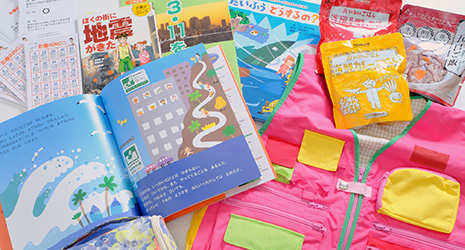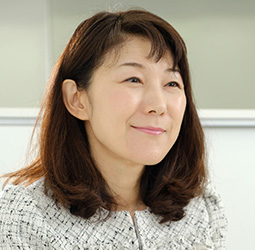Home > Highlighting JAPAN > Highlighting Japan March 2018 > Technologies for Disaster Mitigation
Highlighting JAPAN


Education to Save Lives
Nobue Kunizaki, a crisis management advisor, advocates disaster prevention methods from the viewpoint of a woman and a mother.
Serving as head of the Risk & Crisis Management Education Institute Co., Ltd., Nobue Kunizaki addresses large audiences about the significance of disaster prevention education, taking advantage of a range of opportunities, including appearances on TV programs as well as lectures, seminars, workshops and related events hosted by schools, companies and local communities nationwide.
In addition to speaking as a mother and a woman about disaster prevention methods at over 200 lectures and events in a busy year, she is involved with activities to develop educational tools and emergency goods for disaster prevention while serving the central and municipal governments as an expert on councils related to disaster prevention.
Kunizaki says, “I took a great interest in disaster management activities in the wake of the Great Hanshin-Awaji Earthquake in 1995. I was completely shocked by the unprecedented devastation of Kobe City, a modern industrialized city, caused by the mega quake.”
The disasters that unfolded in Kobe made Kunizaki realize that she did not have enough knowledge about disaster prevention. Motivated by a strong desire to learn, she read a large number of books on earthquakes and disaster management at Kanagawa Prefecture Library.
As she plowed through library books, she realized that many had been written from a male perspective, which made her feel uncomfortable. In addition, further drawing from experience of the situation following the devastating Great Hanshin-Awaji Earthquake, she felt the need to revive some of Japan’s traditional disaster prevention countermeasures. She also felt it important to disseminate knowledge from new perspectives based on scientific insights appropriate to the current condition of society and the social structure. Subsequently, she advocates methods (based on scientific insights) to prevent disaster.
Kunizaki published a book in 2001, introducing her unique methods and insights that replaced stereotypical knowledge about disaster prevention. Since its publication, the book has attracted a great deal of attention as a guidebook for disaster prevention education, consequently filling her life with lectures and work on other publications.
In her activities, including lectures, book publications and TV and radio appearances, she emphasizes the importance of being prepared for a disaster as a part of everyday life. For example, she recommends using ordinary products, supplies or food commonly seen in our daily lives in place of goods designed exclusively for emergencies. Kunizaki also introduces easy ways to become accustomed to staying prepared for a disaster with some suggestions about how to become more aware of disaster prevention during leisure and everyday activities.
Besides inspiring adults to save children, she emphasizes that it is important to spark a child’s interest and provide them with hands-on learning opportunities to properly save themselves with a real feel for the concrete methods.
One of the skills for a child to survive a major earthquake is to get down on their knees while covering their head with both hands, similar to an isopod. This will protect the child from being hit by a falling object. Kunizaki also introduces a demonstration with eggshells that teaches children about the real danger of walking on shattered glass in the event of an earthquake.
“Japan has a sophisticated disaster response system, but we do not have enough educational tools for kids to learn survival skills in the event of a major earthquake, depending on their age. I will try to create as many opportunities as possible for children to learn survival skills, because what they have learned or experienced in childhood may impact the rest of their lives. I am involved with activities to develop a diverse range of educational tools for children, including picture books, comics, videos, games and others, helping them to develop an interest in disaster management activities,” says Kunizaki.
Kunizaki undertakes these activities not only in Japan but in devastated areas abroad as well. In 2005, the year following the Indian Ocean off Sumatra Earthquake, she visited the Indonesian island of Sumatra which had been devastated by the subsequent tsunami, and helped local school children to learn disaster prevention methods to protect themselves from an earthquake or tsunami using picture books, comics and other educational materials. After that visit, she became even more concerned and focused on the skills to survive tsunami based on her experience seeing the resultant devastating damage in the field.
Kunizaki delivered a speech in Ofunato City, Iwate Prefecture, only a month before the Great East Japan Earthquake in March 2011. She addressed the local audience, mostly mothers and housewives, about the importance of sprinting up a hill to evacuate after the quake, showing photos of damage caused by the Sumatra Earthquake.
Later, one of the people in the audience called her and said, “I would not have sprinted up the hill if I hadn’t been in your audience.”
Says Kunizaki, “Fortunately, everyone in the audience survived the tsunami. Your knowledge sometimes plays a critical role in surviving a disaster. I am committed to promoting educational activities for disaster prevention, aiming to achieve a society where every citizen feels comfortable with disaster management initiatives as part of everyday life.”
Kunizaki is currently involved in activities to develop new disaster prevention tools, including smartphone apps, as continues her efforts to promote disaster prevention education and prevent another tragic disaster.
© 2009 Cabinet Office, Government of Japan








